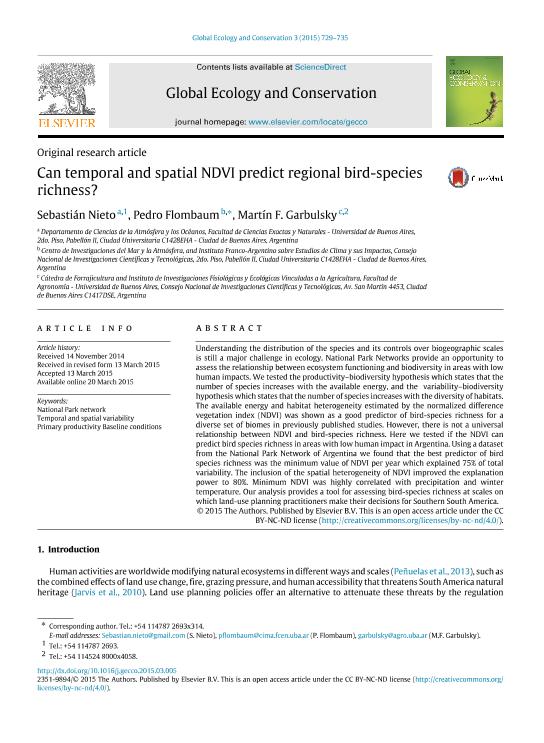Artículo
Can temporal and spatial NDVI predict regional bird-species richness?
Fecha de publicación:
03/2015
Editorial:
Elsevier
Revista:
Global Ecology and Conservation
ISSN:
2351-9894
Idioma:
Inglés
Tipo de recurso:
Artículo publicado
Clasificación temática:
Resumen
Understanding the distribution of the species and its controls over biogeographic scales is still a major challenge in ecology. National Park Networks provide an opportunity to assess the relationship between ecosystem functioning and biodiversity in areas with low human impacts. We tested the productivity–biodiversity hypothesis which states that the number of species increases with the available energy, and the variability–biodiversity hypothesis which states that the number of species increases with the diversity of habitats. The available energy and habitat heterogeneity estimated by the normalized difference vegetation index (NDVI) was shown as a good predictor of bird-species richness for a diverse set of biomes in previously published studies. However, there is not a universal relationship between NDVI and bird-species richness. Here we tested if the NDVI can predict bird species richness in areas with low human impact in Argentina. Using a dataset from the National Park Network of Argentina we found that the best predictor of bird species richness was the minimum value of NDVI per year which explained 75% of total variability. The inclusion of the spatial heterogeneity of NDVI improved the explanation power to 80%. Minimum NDVI was highly correlated with precipitation and winter temperature. Our analysis provides a tool for assessing bird-species richness at scales on which land-use planning practitioners make their decisions for Southern South America.
Archivos asociados
Licencia
Identificadores
Colecciones
Articulos(CIMA)
Articulos de CENTRO DE INVESTIGACIONES DEL MAR Y LA ATMOSFERA
Articulos de CENTRO DE INVESTIGACIONES DEL MAR Y LA ATMOSFERA
Articulos(IFEVA)
Articulos de INST.D/INV.FISIOLOGICAS Y ECO.VINCULADAS A L/AGRIC
Articulos de INST.D/INV.FISIOLOGICAS Y ECO.VINCULADAS A L/AGRIC
Articulos(OCA PQUE. CENTENARIO)
Articulos de OFICINA DE COORDINACION ADMINISTRATIVA PQUE. CENTENARIO
Articulos de OFICINA DE COORDINACION ADMINISTRATIVA PQUE. CENTENARIO
Citación
Nieto, Sebastián; Flombaum, Pedro; Flombaum, Pedro; Can temporal and spatial NDVI predict regional bird-species richness?; Elsevier; Global Ecology and Conservation; 3; 3-2015; 729-735
Compartir
Altmétricas




